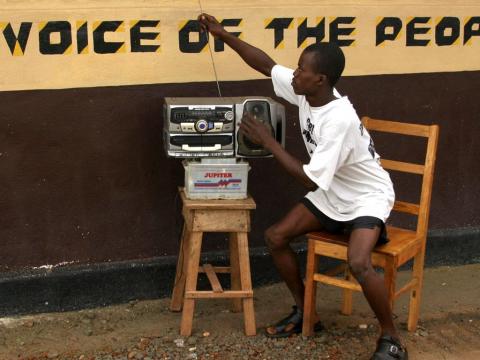By Isaac Massaquoi
By calling for the reclassification as commercial broadcasters of many of what we have known all this while as Community Radio Stations across Sierra Leone, the National Telecommunications Commission (NATCOM) has thrown a grenade into a situation that has clearly remained a regulatory stalemate in the media industry.
This is an issue which the Independent Media Commission (IMC) – not NATCOM – should have handled. They are the appropriate authorities and those knowledgeable to do so, as far as content is concerned. IMC past and present failed to do just that. And NATCOM should be careful how to dabble into it.
The early Community Radio Stations
When community broadcasting started in Sierra Leone at the end of the war at the turn of the millennium, it was principally funded by two organizations – the Open Society Initiative for West Africa (OSIWA) and the Dutch government under its Initiative for the Mobile Training of Community Radio (INFORMOTRAC). The radio stations which emerged from both efforts were located in communities that, at the best of the pre-war times, were viciously poor and cut off from particularly Freetown which many thought was Sierra Leone because of the appalling condition of the road network and communication facilities including the state broadcaster.
In large parts of the country, most people depended on foreign broadcasters like the BBC or some neighboring countries for information, even about the war at home. So it was now up to those community broadcasters to get some conversation going about crucial things like health, education, agriculture and even the rebuilding of the shattered nation by guiding their communities through those early years of post-war fragility and eventually beginning to play some kind of traditional watchdog function following the restoration of local governance in 2004.
The next few years that followed witnessed an upsurge in the number of community broadcasters that came on air. Many were funded by donor agencies. So when Sierra Leone consolidated peace and moved from the world ranking as emergency case donor, money went dry and that began to have a direct impact on the management of community radio stations in two of the most crucial aspects of what makes them unique from commercial broadcasters. I am talking about the areas of Management and Programming.
I served as a consultant for the NGO Network Movement for Justice and Development (NMJD) with a mandate to work with a network of volunteers to set up Eastern Radio which initially operated only out of the eastern headquarter town of Kenema. It was conceived to serve a Community of Interests as opposed to a geographic one that NATCOM appears to be alluding to. Then, as now, the three eastern districts of Kenema, Kailahun and Kono were interested in all issues connected to mining and agriculture and their program schedules for a long time reflected those concerns plus a heavy dose of basic education programs. So, for example, environmental degradation as a consequence of mining operations, children in the mines, fair corporate social responsibility payments to communities affected by mining in Kenema and Kono, the difficulties in agriculture and cross-border trade in Kailahun were the common themes running through all programs.
As it turned out Eastern Radio became a victim of its own ambitions - community support slowed down and crucial donor funding dried up. The station’s governance structures fell into inertia – it’s unwieldy 100 or more member Governing Council drawn from across the three districts was unable to meet because it was simply too expensive to convene. And despite the use of other innovative methods of keeping the station on air, Eastern Radio – that unique, well-resourced experiment in community broadcasting – had to largely depart from its community programming backbone to enter the open but crowded market in search of advertising and sponsorship revenues. This was the case in many other community radio stations that tried to operate in line with all the elements in the IMC definition.
The call for reclassification
The National Telecommunications Commission (NATCOM) is now pushing for some of these radio stations serving a population of 10,000 or more with a maximum radiated power beyond a certain prescribed limit to be reclassified as commercial broadcasters and because they believe those stations are hiding behind the cloak of “Community” to escape paying the required annual taxes.
I get the point they are making and I am happy they have raised an issue which for a long time many had shied away from, for no reason other than political correctness. So I have some concerns to now bring up particularly with the IMC which established the different categories of radio stations in the first place and which should ultimately carry out the reclassification issue that NATCOM is talking about if or when we get to that stage.
The IMC code says: “A community radio/television is one which is for, by and about the community, whose ownership and management is representative of the community, which pursues social development agenda and which is not for profit.” In a practical sense, this means to qualify as a community radio at any time, radio stations found mostly in the rural areas of the country must be owned by the people in that community. And their governance structures such as board composition should be so selected that everybody – youth (male and female), the aged, religious leaders and other social groupings in a particular community – feels part of the station.
Of crucial importance also is their programming which should be entirely focused on helping educate the people in their communities so that they take control of their lives by improving their communities and advocating for development in their areas. Finally whatever monies come into the station as profit should be declared to the board so constituted and used for community projects. In other words the management of such stations should never think of making huge profits beyond what is required to keep the station on air by meeting recurrent expenditure including the cost of maintenance and paying stipends to community volunteers who produce the programs.
For the IMC to reclassify any of these community radio stations, therefore, these are the elements they should consider to determine whether this definition applies in operational terms with what obtains in the stations registered with them within a certain period.
They will also have to address NATCOM’s concerns that some of the stations are clearly modulating over and above the limits prescribed for that category of license, plus the very thorny issue of some stations having abandoned their Community Radio character and operating like any commercial radio in any country – entertaining all the time and prioritizing the maximization of advertising revenue over community service.
About two years ago I led a study into the governance of community radio stations across the country. It was funded by the Media Reform Coordinating Group (MRCG) as part of its laudable media reform agenda. So as not to bore you with the gory details, we found out that some of these community radio stations have clearly moved away from their Community Radio character in the process losing the very community they were set up to serve. With some, governing boards have remained the same since 2004 and have either not met in years or are non-existent.
I suggest that for many of these radio stations we may not need to reclassify, rather to help or compel them to return to their community form within a particular timeframe, monitored for compliance by the IMC and a multi-stakeholder group including NATCOM. What’s the point making them commercial broadcasters and placing a huge financial burden of them which will surely close them down? Even as community broadcasters they have been unable to meet their relatively small annual registration fees.
Another variable we have to consider is the position of the state broadcaster, the SLBC. Its constitutive instrument restricts it from pursuing call to action advertising as enshrined in the following words of Section 10 of the 2010 Act that established it: “the corporation shall allow and accept limited sponsorship for programmes and advertisement, except that no sponsorship shall be allowed for news programs or accepted from political, ethnic or religious groups or institutions”.
Now compare this section quoted above to the reality on the ground at SLBC. The corporation is badly struggling despite guaranteed state funding. The station continues to drive for the limited advertising revenue available perhaps to meet the inevitable shortfall in government funding. So while we push to reclassify those community radio stations in the line of fire right now, we should consider what actions to take to release community radio stations from all the operational pressures they face such as telling the state broadcaster to keep within its public service limits which might be compromised by overreliance on advertising. Let the government pay the significant bulk of money required to run the state broadcaster.
We should be extremely careful when we reclassify so that we don’t destroy fantastic examples of community broadcasting as done in Radio Gbafth in Mile 91, Voice of Peninsular Mountains in Tombo, Radio Moa in Kailahun and Radio Kolenten in Kambia among a few others that have, as far as possible, stayed with the Community Radio mandate.
© 2019 Politico Online









